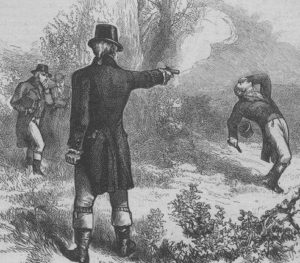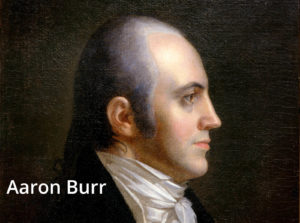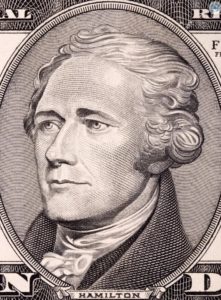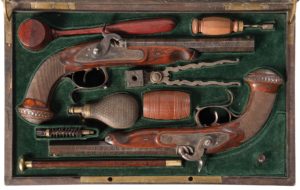On July 11, 1804, Aaron Burr, a sitting vice president, shot and killed Alexander Hamilton in a duel, referred to as “an affair of honor,” back in those days.
Is it important? Perhaps so. If nothing else, campaigns of yesteryear were more turbulent than those of today. While the nastiest campaign was between Andrew Jackson and John Quincey Adams, the 1800 election ranks toward the top. A reader of history will find the dirtiest, nastiest campaigns were those in the 1800s. Anyway, for the duel, reasonably common then, you first need to go back to the election in 1796. The first actual election, in a sense, we had in this country.
nastiest campaigns were those in the 1800s. Anyway, for the duel, reasonably common then, you first need to go back to the election in 1796. The first actual election, in a sense, we had in this country.
Burr ran for the vice presidency that year with Thomas Jefferson’s Democratic-Republican ticket (the forerunner of the Democratic Party). Hamilton and Burr had a long history of animosity, and Hamilton launched a series of public attacks against Burr, stating, “I feel it is a religious duty to oppose his career.” John Adams won the presidency, and in 1797 Burr left the Senate and returned to the New York Assembly. A word about the Electoral College in the next paragraph because it was a little different then. It’s incorrect to say Burr ran for the vice presidency.
In 1800, Jefferson, at the head of the ticket, chose Burr as a running mate, sort of. Keeping in mind this was before the Internet,  Burr helped the Democratic-Republican party by publishing a confidential document that Hamilton had written critical Federalist candidate and President John Adams. Hamilton was a Federalist. The confidential memorandum caused a division among the Federalists and helped Jefferson and Burr win the election with 73 electoral votes each. Bear in mind both men had the same number of electoral votes.
Burr helped the Democratic-Republican party by publishing a confidential document that Hamilton had written critical Federalist candidate and President John Adams. Hamilton was a Federalist. The confidential memorandum caused a division among the Federalists and helped Jefferson and Burr win the election with 73 electoral votes each. Bear in mind both men had the same number of electoral votes.
Back then, candidates ran separately, not together. The person with the most votes would be president, and the person coming in second would be vice president. That’s how John Adams served as president and Jefferson as vice president after the election of 1796, a practice no longer in effect. The election was thrown into the House of Representatives to choose a winner. Interestingly enough, there were 35 tie votes in the House.
A group of Federalists, led in good part by Hamilton, supported Jefferson. Hamilton did it as the lesser of two evils. Jefferson won, and Burr became vice president. Burr already didn’t like Hamilton, and this added fuel to the fire. But there’s more.
In 1804, Jefferson distanced himself from Burr. The Federalists, sensing an opportunity, tried to pull Burr into their party. Although he was still vice president, a group of Federalists tried to run Burr for governor of New York. One big problem, though.  Hamilton campaigned against Burr, and he lost the Federalist nomination. Well, Burr didn’t give up and ran as an independent for governor. In the campaign, Burr’s character was ruthlessly attacked by Hamilton and actually by others. Still, it was Hamilton that Burr hated, and to preserve or restore his reputation, Burr challenged Hamilton to a duel.
Hamilton campaigned against Burr, and he lost the Federalist nomination. Well, Burr didn’t give up and ran as an independent for governor. In the campaign, Burr’s character was ruthlessly attacked by Hamilton and actually by others. Still, it was Hamilton that Burr hated, and to preserve or restore his reputation, Burr challenged Hamilton to a duel.
Duels rarely ended with anyone shot, and some believe Hamilton fired first and intentionally missed. No one knows that for sure except for a letter he wrote the night before. The letter somewhat implies he was going to do this, figuring Burr would then intentionally miss, and differences could be resolved. Now Burr was  a bit of a wild man if you read his history, but the thing is, he didn’t miss. He shot Hamilton in the stomach, and he died the next day. The picture is misleading because it looks like a shot to the head.
a bit of a wild man if you read his history, but the thing is, he didn’t miss. He shot Hamilton in the stomach, and he died the next day. The picture is misleading because it looks like a shot to the head.
Burr got into some other things, which included being charged with treason three years later but was acquitted on a legal technicality and spent the rest of his life publicly disgraced. Hamilton ended up with his face on the sawbuck.
So, the 2016 election, as many believed, was on the tame side compared to it, except in 1804, when the fight was between those running, not between voters. The Electoral College, the law of the land in the Constitution, changed, so in 2016, it was Trump/Pence against Clinton/Kaine. In the aftermath, the fight continued. But the Constitution worked and continues to work.